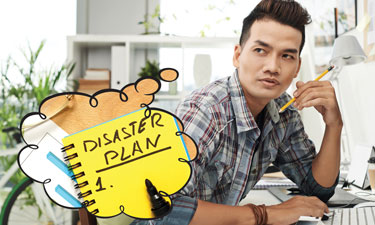 Whether natural or man-made, disasters cause many of us to feel increased levels of stress and anxiety, and for those already dealing with mental health issues, can prove to be even more challenging. Stockpiling supplies, such as water, food, batteries and other emergency items to meet physical needs, not only helps us to be prepared, but also gives us a sense of control and calmness in the event of a disaster — we at least have a plan.
Whether natural or man-made, disasters cause many of us to feel increased levels of stress and anxiety, and for those already dealing with mental health issues, can prove to be even more challenging. Stockpiling supplies, such as water, food, batteries and other emergency items to meet physical needs, not only helps us to be prepared, but also gives us a sense of control and calmness in the event of a disaster — we at least have a plan.
However, disaster preparedness doesn’t stop at taking care of the physical needs. Protecting your mental well-being and that of your agency patrons is also a major factor in how you “weather the storm.” The American Public Health Association (APHA) says, “Strong emotional reactions to witnessing a disaster and facing its aftermath are perfectly normal. But like all preparedness activities, knowing what you’re in for can boost your resiliency and help you cope in healthy ways.”
Disasters come in all shapes and sizes, from hurricanes, wildfires, tornadoes and heat waves, to infectious diseases, mass shootings and acts of terrorism. The Ready campaign website, sponsored by the Federal Emergency Management Agency (FEMA) and the Department of Homeland Security (DHS), provides information about how to prepare for various disasters, and includes a section about coping with different disasters and the stress related to disasters.
Planning Is Key
The more prepared you are, the more likely it is that when a disaster strikes you may be able to quickly regain your composure and think clearly about what your next steps should be. The APHA recommends that the first thing to do when planning for disaster is to do the research. Determine, for example, what kinds of natural disasters can happen in your community, is there a chance residents will need to evacuate, and what might be required of municipal service providers? Also, should your agency be in a position to offer immediate shelter, is the shelter safe, stocked with supplies and manned by professionals who know how to comfort residents who are seeking shelter and care? On its Get Ready webpage, the APHA provides a wealth of resources, including fact sheets covering a variety of disaster situations and expert advice to help get you and your agency started with planning.
Signs of Disaster-Related Stress
According to Ready.gov, in disaster situations, “Children, senior citizens, people with access of functional needs and those for whom English is not their first language are especially at risk. Children may become afraid and some elderly people may seem disoriented at first. People with access or functional needs may require additional assistance.”
Reactions to a disaster vary from person to person, with shock and disbelief, difficulty concentrating, trouble sleeping, changes in eating habits, changes in alcohol and tobacco use, dramatic mood swings, and feelings of anger, guilt and grief among some of the most common emotional responses. Depending on age, a child’s emotional responses can range from irritability, excessive crying and wanting to held and cuddled more, to a preoccupation with the details of the event and dangerous, risk-taking behavior. The length of time these emotions last also varies from person to person and, according to the APHA, is often linked to the severity of the disaster and the magnitude of a community’s recovery.
Becoming familiar with signs of disaster-related stress will help park and recreation professionals react quickly and deftly when caring for and sheltering residents of all ages and abilities.
Coping Mechanisms
Breathing, relaxation and meditation exercises, as well as cognitive restructuring — a useful technique for understanding and reframing the negative thinking that we all experience from time to time — can be helpful in the midst of a disaster and are easily adapted to almost any space. Ready.gov offers the following tips for dealing with disaster-related stress:
- Talk with someone about your feelings — anger, sorrow and other emotions — even though it may be difficult.
- Seek help from professional counselors who deal with post-disaster stress.
- Do not hold yourself responsible for the disastrous event or be frustrated because you feel you cannot help directly in the rescue work.
- Take steps to promote your own physical and emotional healing by healthy eating, rest, exercise, relaxation and meditation.
- Maintain a normal family and daily routine, limiting demanding responsibilities on yourself and your family.
- Spend time with family and friends.
- Participate in memorials.
- Use existing support groups of family, friends and religious institutions.
Building your resilience is another great tool to help deal with stress-inducing situations, particularly when the changes you’ll be charged with comforting others is high. Contrary to popular belief, resilience is not an inherent trait. The American Psychological Association says, “It involves behaviors, thoughts and actions that can be learned and developed in anyone.” It goes on to say that a combination of factors contribute to resilience — the capacity to make realistic plans and take steps to carry them out and the capacity to manage strong feelings and impulses, to name a few — but they are attributes people can develop in themselves.
Being able to recognize the signs of disaster-related stress in yourself and your patrons, as well as having some mechanisms for working through those stresses, are important tools to include in your disaster-preparedness kit.
Sonia Myrick is the Managing Editor of Parks & Recreation magazine.

